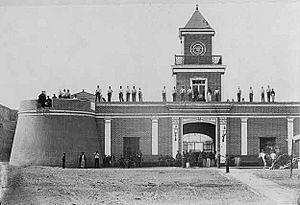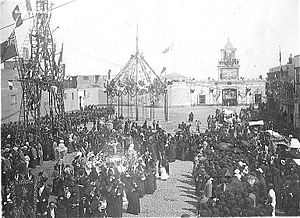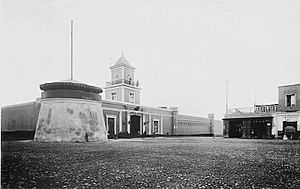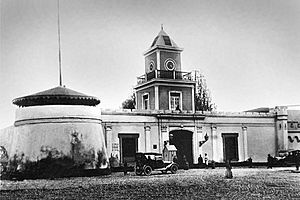Fort of Santa Catalina, Lima facts for kids
The Fort of Santa Catalina (in Spanish: Fuerte de Santa Catalina) is an old military building in Lima, Peru. It's a special example of military architecture from the time when Peru was a Spanish colony. Built in the early 1800s, it stands on land that once belonged to two monasteries. This fort is partly still standing and is in good condition. It is one of the few colonial military buildings left in Peru. The land it sits on is owned by the Peruvian government and covers about 25,250 square meters. A famous Peruvian writer, Ricardo Palma, wrote that the building of the Santa Catalina Barracks started during the time of Viceroy Gabriel de Avilés. It was meant to be a place for artillery (big guns like cannons). The work was led by Colonel Joaquín de la Pezuela, who later also became a Viceroy.
Contents
Where is the Fort of Santa Catalina?
The Santa Catalina Barracks is located on Jirón Inambari, at the corner of block 12 of Jirón Andahuaylas. This area is known as Plazuela de Santa Catalina in the Barrios Altos part of Lima.
What does the Fort look like?
| UNESCO World Heritage Site | |
|---|---|
| Criteria | Cultural: iv |
| Inscription | 1988 (12th Session) |
| Area | 259.36 ha |
| Buffer zone | 766.70 ha |
Outside the Fort
The front of the fort has a corner tower made of adobe, which is a type of mud brick. The main entrance is a large wooden door in the Neoclassical style. This means it looks like old Greek and Roman buildings. It has tall, thin columns called pilasters with fancy tops (Corinthian and Ionic styles). There's also a square wooden tower, which used to have a clock. You can also see old cannons used as gutters near the door. The walls have towers on the sides and merlons, which are the solid parts of a castle wall that you can hide behind. These merlons have narrow openings called arrowslits for shooting.
A famous architect from Lima, Héctor Velarde, said that the barracks is a great example of military building from the last years of the Spanish colony. He noted its wide, sloped adobe walls and corner towers. He also said it's important for the city because it helps shape the look of the Santa Catalina square.
César Miro, from the El Comercio newspaper, described the front of the fort. He mentioned that the historic barracks had a clock where time seemed to stop. It also had a tower to watch for people planning rebellions, as it was a place where rebels could hide.
Inside the Fort
César Miro also described the inside of the Fort of Santa Catalina. He said it was like a giant building made of adobe. Old plans show it as a rectangle with strong corners. It had a large area, with guards for soldiers and officers. There were also many rooms, stables for horses, storage areas, and a workshop for military equipment. People say that English pirate prisoners, accused of stealing, helped pave the inside.
There was a chapel inside dedicated to Saint Barbara, who is known as the patron saint of explosions. The chapel had paintings by Matías Maestro, an artist and architect. He was a priest who helped design many important buildings in Lima, like the Cathedral and other churches. He is also famous for designing the cemetery named after him.
When you walk through the big wooden entrance, you enter a cobblestone path. This path leads to the main courtyard, which is called the "courtyard of arms." It has been partly fixed up. In the middle of the courtyard, you can still see the old flagpole and an old cannon. To the right, there's a two-story building with a colonial balcony, which is a bit run down. Inside the barracks, you can see rooms that used to be offices. These have been fixed up to be classrooms and offices now. There's also a cell and offices with large windows that face the front of the building.
The main materials used to build the barracks were adobe (mud brick) and stone. Quincha, a mix of cane and mud, was used for the second floor of some parts. Wood was also used for the big square tower and the colonial balcony. The floors inside are made of wood, and so are the stairs. All the outside windows have simple metal grates, which was common in the Neoclassical period.
History of the Fort
The Fort During the Viceroyalty
In 1698, a monastery gave some land to a person named Juan del Águila Angulo. This land was later passed to Pedro Tramarría and then to his wife. Later, in 1806, the government, represented by Colonel Joaquín de la Pezuela, rented this land. This allowed a long-planned project to finally begin: building a barracks for the artillery corps. This corps handled heavy weapons like cannons and also had skilled workers for cavalry (soldiers on horseback) and making gunpowder.
The construction started on August 22, 1806. This was ordered by Viceroy José Fernando de Abascal y Sousa, who was in charge from 1806 to 1816. The work was led by Joaquín de la Pezuela, who later became Viceroy himself.
The main reason for building this barracks, first called "Santa Catalina Artillery Barracks of Lima," was to make the capital city safer. Spain wanted to protect its colonies from attacks by the English, who were interested in their wealth. Another reason was to better organize the artillery forces of the Viceroyalty. The barracks helped improve the artillery and make it stronger.
Over time, the barracks was used not only by the artillery of the Royalist Army but also by infantry (foot soldiers) and cavalry. During this period, the Fort of Santa Catalina became the strongest Spanish military base in South America. From here, weapons and troops were sent to other parts of the Spanish colonies to stop any uprisings against Spain.
The Fort During Emancipation
During the time when Peru was fighting for its independence from Spain, this barracks was used by both the Spanish loyalists and the Peruvian patriots. Both sides used its workshops and spaces for shelter and supplies.
The Fort in the Republic Era
After Peru became a republic, military supplies were still managed through the General Command of Artillery, which included the stores, workshops, and gunpowder factory. The stores and workshops continued to operate at the Santa Catalina Barracks until the late 1800s.
The coat worn by Marshal of Peru Agustín Gamarra during the Battle of Ingavi in 1841 was kept at the Fort of Santa Catalina for many years.
In 1845, the Artillery Application School began to be built within the barracks. This school was a forerunner of the Military College that would later replace it.
During a coup d'état (when a group tries to take control of the government by force) against President José Balta y Montero on July 22, 1872, Army Colonel Tomás Gutiérrez moved his troops to the Santa Catalina Barracks. Barricades were built in front of the barracks, and the water and gas lines were cut. On July 26, 1872, Tomás Gutiérrez and his brother, Colonel Marcelino Gutiérrez, left the barracks with their troops, firing guns and cannons. The people trying to stop them had to retreat for a moment.
During the War of the Pacific (1879-1884), the Santa Catalina Artillery Barracks had cannons that were copies of a special model. In January 1881, the Chilean army entered Lima and looted the Santa Catalina Barracks. They took all the military equipment and valuable historical weapons.
In the 1890s, the Fort of Santa Catalina was the home of the Mountain Artillery Brigade of the Peruvian Army.
In those years, every July 28, which is Peru's national independence day, a salute of cannons was fired from the Fort of Santa Catalina at sunrise. This announced the day when General José de San Martín declared Peru's independence.
In the early 1900s, the military stores and workshops that were in the Santa Catalina Barracks moved to another barracks.
This barracks has seen many historical events, including popular protests and military rebellions throughout Peru's history as a republic.
On February 4, 1914, another coup d'état happened against President Guillermo Billinghurst. The Infantry Battalion, which was stationed at the Santa Catalina Barracks, joined the military uprising. During this event, the Minister of War and Navy, General Enrique Varela Vidaurre, died at the Santa Catalina Barracks.
In the same year (1914), President Colonel Óscar R. Benavides ordered part of the Mountain Artillery Regiment, also based at Santa Catalina, to move to the city of Arequipa.
A less remembered event is the uprising of soldiers from the Infantry Regiment on March 23, 1931. This uprising was led by Sergeant Víctor Faustino Huapaya Chacón. At that time, the Santa Catalina Barracks was a very important military base.
The rebellious soldiers took control of their officers and then went into the streets with tanks, firing machine guns and rifles. They tried to take over the Ministry of Government and Police and the Government Palace, but they were stopped. They rang church bells, causing alarm. When the rest of the Army fought back, the rebels had to return to the Santa Catalina Barracks. Government troops then surrounded them. To talk things over, some ministers and officers entered the barracks and met with Sergeant Huapaya. The rebels had a list of demands, including the release of a former president and better barracks.
The government rejected their demands, and the fighting started again. Two planes dropped grenades in the barracks courtyard. After this, the rebels gave up. Many people were hurt or died. Sergeant Huapaya was sentenced to prison, but he was later released.
By a special government order on January 19, 1946, the Barracks was declared a National Historic-Artistic Monument. Its care was given to the National Institute of Culture (INC). This was confirmed again in 1972.
The Santa Catalina Barracks was also declared an "intangible" site by the Lima city council. This means its original walls and a tower should be protected. You can still see these walls around the State College No. 1035 "General de División EP José del Carmen Marín Arista" and a tower at the corner of Jirón Andahuaylas with Inambari.
However, in 1963, part of the building was torn down to make way for the extension of Nicolás de Piérola Avenue. Later, parts of the land were given to the Ministry of War and the Ministry of Education.
Until the late 1970s, the barracks served as the headquarters for the Military police of the Peruvian Army. You can still see the Military Police's Code of Honor, the Coat of arms of Peru, and their emblem on one of the barracks walls.
In 1976, when the Fort of Santa Catalina was a Military Police Battalion barracks, a former army captain was held there after being sentenced by military justice.
During the second government of President Fernando Belaúnde Terry (1980-1985), another part of the building was demolished. This was to build a new prison called "San Jorge." Soon after, another part of the building was removed to build the "General de División EP José del Carmen Marín Arista" school, which opened in 1983. The Chapel of Saint Barbara was not touched, but its surroundings changed because it is now very close to a perimeter wall instead of being in front of a large courtyard.
What is the Fort like today?
The building is now owned by the National Institute of Culture. Only about one-fifth of the original building remains, including the front part and the chapel of Santa Bárbara. These parts are in good condition.
After some archaeological work, the building was restored by the Escuela Taller de Lima, a restoration school supported by Spain. This school is working to fully restore this important monument.
See also
 In Spanish: Fuerte de Santa Catalina (Lima) para niños
In Spanish: Fuerte de Santa Catalina (Lima) para niños






